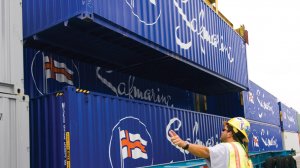Although South African container trade started off with a bang in 2015, with the market growing by 7% during the first half of the year compared with the same period in 2014, the second half of 2015 saw a significant slowdown, recording a 1% decline.
In fact, in the fourth quarter of 2015, the market contracted by 5%, states the fourth-quarter Maersk Trade Report, with container imports declining by 4% and container exports by 6%.
The Asian import market, in particular, was down by 9%, which is a sign that the weaker rand and lower consumer confidence are weakening import demand, says Maersk Line Southern Africa MD Jonathan Horn.
Asia represents about 55% of South Africa’s total container import market, and includes retail, electronics and consumer goods.
Total container exports from South Africa grew 12% in 2013 compared with 2012, 0.8% in 2014 and 0.8% in 2015 as the economy steadily cooled. Container imports grew 4.1% in 2013, contracted by 5.5% in 2014, then increased again by 4.9% in 2015.
Horn says the South African container export market consists predominately of commodities, including chrome, manganese, scrap metal and copper, which are the backbone and driving force of South Africa and many economies in Africa.
However, the recent drop in global demand, mostly due to China’s slowing economy, has hit Africa hard. There has, for example, been a significant drop in manganese exports from South Africa.
“Despite the drop in commodity prices, many countries around the world are still dependent on Africa’s resources. China, for example, depends on Angola for oil and on Zambia for copper, and although the rate at which [China] imports these commodities will slow, the need will remain,” says Horn.
Maersk Line Southern Africa trade manager Matthew Conroy says exports from South Africa are not expected to rebound in the first half of 2016 as global demand for mineral commodities – particularly from China – is expected to be flat.
He says low prices are making some mines and, similarly, the container market, unprofitable, forcing mines to curtail production.
“We do not expect to see significant container market growth in 2016, and it is likely that the declining trend recorded during the fourth quarter will continue into the first half of 2016.
“And, as the rand remains volatile, imported goods will remain expensive to South African consumers who already have less money to spend.”
Dirk Hoffmann, MD at Safmarine Southern Africa, a member of the Maersk Group, believes the export of manufactured goods remains the biggest opportunity for South Africa and the container market this year, based on the weakening rand.
“The refrigerated export market continued to see robust growth of approximately 7% in 2015, which is attributed to strong crop output of apples, pears, grapes and citrus during the year, with grapes showing the strongest growth relative to a poor 2014, coupled with stronger prices in Europe,” he adds.
Hoffmann says it is expected that the local fruit market will grow in 2016 but, with the drought and excessive heat, the fruit industry is likely to see less exports over the next 12 months.
“The impact will vary widely based on geography, but the Western and Northern Cape are likely to be the hardest hit. Although it is expected that almost all fruit types will be negatively impacted by the drought, the full impact will only be determined in coming months, when the fruit is picked.”
Hoffmann says the export vehicle market remains stable. However, lower expected consumer spend in 2016 will impact negatively on vehicle demand in South Africa.
He says the biggest container growth opportunity in the vehicle segment is within Africa, as a result of countries such as Nigeria purchasing more from South Africa.
When it comes to volume, the top import trade lanes from South Africa in 2015 were the Far East and Asia (mainly vehicles, textiles, apparel and electronic goods), Europe (mostly made up of vehicles, machinery and electronic goods) and the Middle East (plastic and rubber, textiles and cereals such as rice, seeds and beans).
The top export trade lanes during 2015 included the Far East and Asia (ore, metal and wood such as paper pulp), Europe (refrigerated cargo, vehicles and food and beverages, such as wine) and the Middle East (metal, refrigerated cargo and ore).
“Overall, the 2016 container market is facing numerous economic obstacles,” notes Hoffmann.
“It is anticipated that the import and export container market will contract by about 5% during the first quarter of this year.”
ZIM TOBACCO
Safmarine has just shipped 622 40-foot containers for one customer from the Durban port, setting a global record for the single biggest shipment of containers for one customer on a single ship, says Hoffmann.
The containers were filled with tobacco from Zimbabwe, with Tian Ze, in China, the customer.
Hoffmann says it appears as if Zimbabwe’s 2015 tobacco production has reached levels last seen in 2000.
Edited by: Creamer Media Reporter
EMAIL THIS ARTICLE SAVE THIS ARTICLE
To subscribe email subscriptions@creamermedia.co.za or click here
To advertise email advertising@creamermedia.co.za or click here













